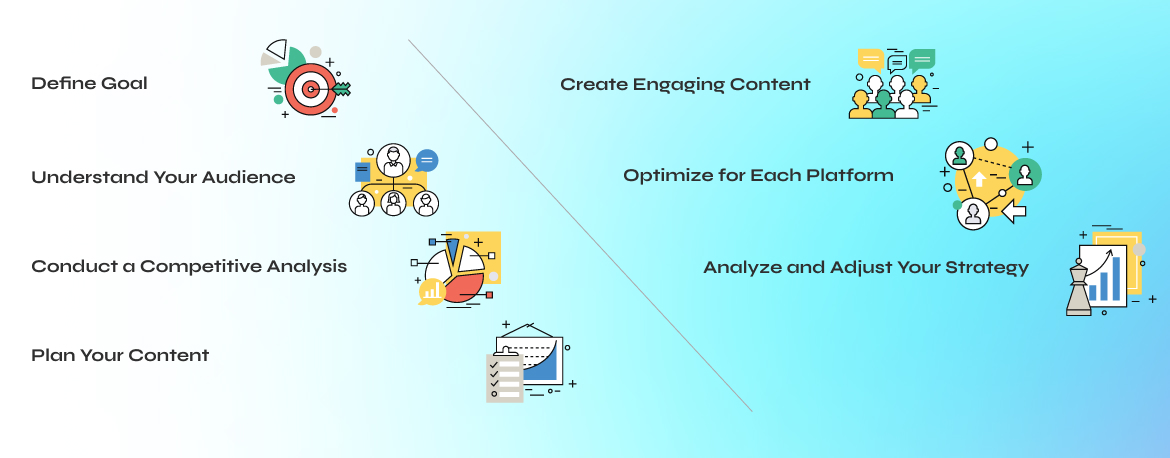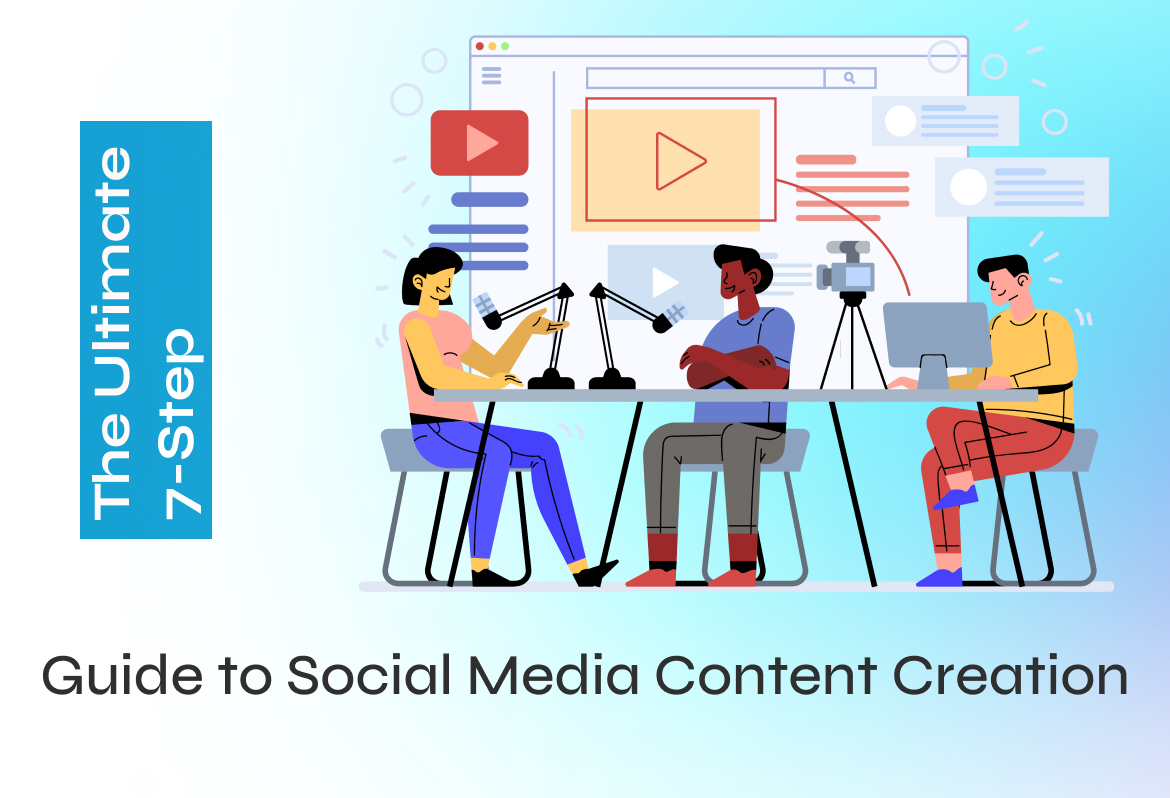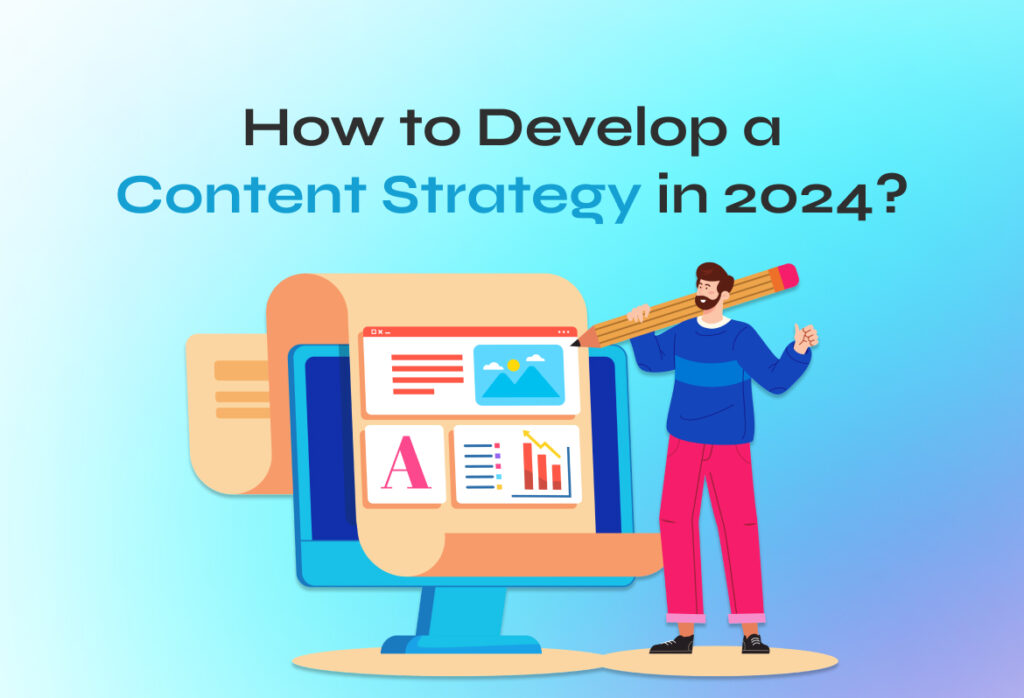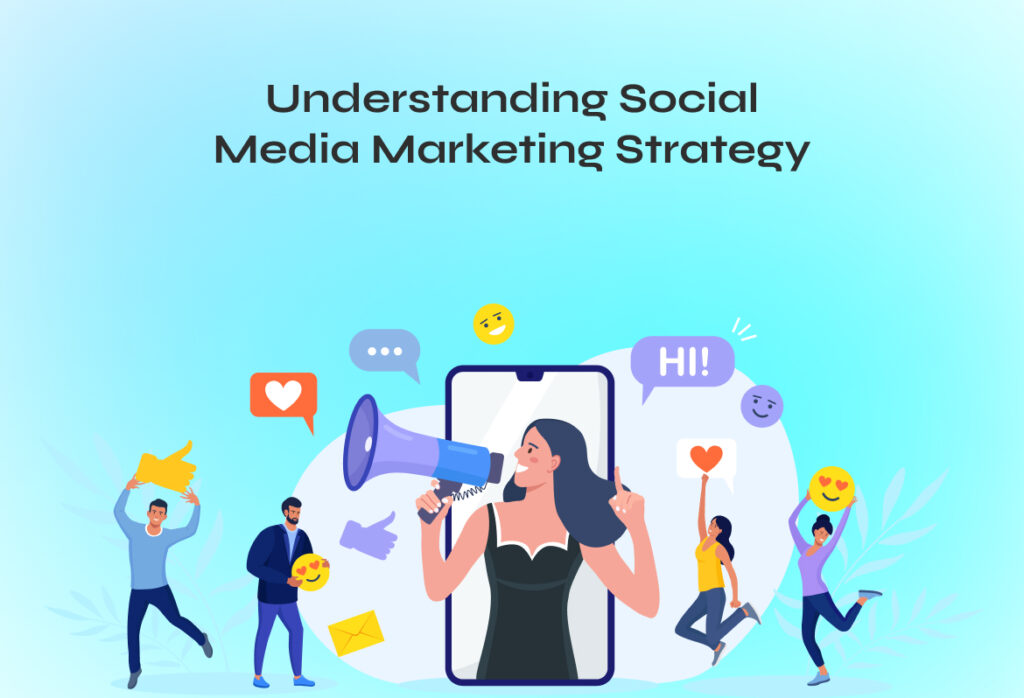Have you ever wondered how to capture your audience’s attention on social media? This concise guide breaks down the art of social media content creation into seven easy steps, helping you engage, expand your reach, and meet your marketing goals.
Each step is critical to boosting your social media marketing efforts, from setting clear goals to fine-tuning your strategy. With practical tips and essential SEO phrases like “social media content creation” and “social media content creation tips,” you’re set to enhance your digital footprint. Dive in as we simplify the process of creating impactful social media content for everyone, from beginners to seasoned marketers.

Define Your Goals
Defining your goals is the first and most critical step in creating effective social media content. Without clear, measurable objectives, your content is like a rudderless ship lacking direction and purpose. Are you aiming to increase brand awareness, boost engagement, drive website traffic, or generate sales? Setting specific, achievable goals gives your content strategy focus and provides a benchmark for measuring success.
Examine your overall business objectives and consider how social media marketing can help you achieve them. For instance, if your goal is to enhance brand awareness, your content should showcase your brand’s identity, values, and what sets you apart from competitors. On the other hand, if increasing engagement is your target, your content needs to be informative but also interactive and relatable, encouraging followers to like, comment, and share.
Remember, goal-setting is not a one-size-fits-all approach. What works for one brand may not necessarily work for another. Therefore, tailor your objectives to align with your brand’s unique needs and capabilities. Setting clear, measurable goals lays a solid foundation for your social media content creation strategy, ensuring every piece of content serves a purpose and moves you closer to achieving your desired outcomes.
Understand Your Audience
The success of your social media content hinges not just on what you say but also on how well it resonates with those you’re speaking to. Understanding your audience is the cornerstone of any effective content creation strategy. It involves delving deep into your followers’ demographics, preferences, and behaviors to create content that speaks directly to their needs, interests, and challenges.
Start by leveraging social media analytics tools on platforms like Facebook Insights, Twitter Analytics, and Instagram Insights. These tools provide valuable data on your audience’s age, gender, location, and even when they are most active online. But understanding your audience goes beyond mere statistics; it’s about grasping the nuances of their online behavior—what they like, share, and comment on—and why.
Engaging with your audience is not just a strategy; it’s an empowerment tool. By asking questions, conducting polls, and initiating discussions, you gain valuable insights into their preferences and foster a sense of community and belonging. You can watch your engagement levels soar by tailoring your content to address their interests and pain points. Remember, the more you know about your target audience, the more impactful your content can become.
Conduct a Competitive Analysis
Navigating the crowded waters of social media requires knowledge of your audience and an understanding of the competitive landscape. Conducting a competitive analysis helps you identify what’s working (or not) for your competitors and uncover gaps in your strategy.
Use tools like BuzzSumo, SEMrush, and Ahrefs to analyze your competitors’ social media performance. Look for patterns in their most engaging content—types of posts, content themes, posting frequency, and engagement tactics. This analysis can reveal insights into your industry’s content trends and audience preferences.
However, the aim is not to imitate your competitors but to identify opportunities to showcase your brand’s uniqueness. Perhaps there’s an underserved topic your audience is interested in, or maybe you can present information in a more engaging, visually appealing way. Competitive analysis is about learning from the landscape to carve out your unique space in the social media sphere, highlighting what makes your brand unique.
Plan Your Content
With clear goals, an understanding of your audience, and insights from competitive analysis, you’re now ready to plan your content. A well-thought-out content plan ensures consistency, critical to building and maintaining an engaged social media following.
Develop a content calendar outlining what to post, when, and where. Your content mix should include a variety of formats—articles, videos, infographics, and interactive content like polls and quizzes—to cater to different preferences and increase engagement. Incorporate critical themes and topics that align with your audience’s interests and your brand’s messaging.
Remember, quality over quantity. It’s better to post less frequently with high-quality, relevant content than to overwhelm your audience with filler material. Use scheduling tools like Buffer, Hootsuite, or Sprout Social to plan your posts, ensuring a steady stream of content without last-minute scrambles.
Create Engaging Content

Creating content that engages and captivates your audience is an art and a science. It’s about striking the right balance between informative and entertaining, ensuring your posts draw attention and encourage interaction. To achieve this, consider the following expanded tips to help you create content that resonates deeply with your audience:
- Be Authentic: Authenticity is the cornerstone of engagement. Your audience can easily distinguish between genuine content and forced marketing. Share real stories, experiences, and insights that reflect your brand’s values and personality. This authenticity fosters a stronger connection and builds trust with your followers, making them more likely to engage with your content and brand.
- Use Visuals: In the visually-driven world of social media, compelling images, videos, and graphics can significantly increase engagement. Visuals grab attention and enhance the message you want to convey. Invest in quality photography, explore creative graphic designs, and use video content to tell stories more dynamically and engagingly. Remember, content with relevant visuals receives 94% more views than content without.
- Tell Stories: People love stories; they’re fundamental to human communication. Use storytelling to make your brand more relatable and create emotional connections with your audience. Whether it’s a customer success story, a behind-the-scenes look at your operations, or your brand’s journey, stories can captivate your audience in a way that straightforward product posts cannot.
- Encourage Interaction: Social media is a two-way street. Create posts inviting your audience to interact through comments, shares, likes, polls, and quizzes. Ask questions, seek opinions, and encourage users to tag friends. This increases engagement and amplifies your reach as users share your content with their networks.
- Leverage User-Generated Content (UGC): UGC is a powerful way to engage your audience and create a sense of community. Encourage your followers to share their own stories, photos, or videos related to your brand or products. Sharing this content on your social media channels provides authentic material and makes your followers feel valued and part of your brand’s story.
- Keep Up with Trends: Being culturally relevant and timely can significantly boost engagement. Monitor trends, hashtags, and challenges within your industry and the broader social media landscape. Participating in these trends can increase your visibility and show your brand’s personality. However, always ensure that the trends align with your brand values and audience interests to maintain authenticity.
- Optimize Posting Times: Timing can impact engagement. Use analytics to determine when your audience is most active and schedule your posts accordingly. While optimal times vary across platforms and audiences, posting when your followers are online increases the likelihood of engagement.
- Experiment with Formats: Social media platforms continually evolve, offering new features and formats for content creation. Experiment with these formats—Instagram Stories, Reels, Twitter Threads, or LinkedIn Articles—to discover what resonates best with your audience. Diversifying your content format keeps your feed fresh and engaging.
By implementing these strategies, you can significantly enhance the quality and engagement of your social media content. Remember, the goal is to create content that reflects your brand’s identity and genuinely interests and engages your audience. Keep experimenting, learning from your successes and failures, and always be willing to adapt your strategy to meet the ever-changing preferences of your social media followers.
Optimise For Each Social Media Platform
Optimizing your social media content for each platform is essential to maximize engagement and reach. Each platform has its culture, algorithms, and audience behaviors, requiring a tailored content creation and distribution approach. Here’s an expanded look at how to optimize your content for key social media platforms:
- Facebook: With almost 3.049 Billion Monthly Active Users, Facebook is ideal for sharing a mix of content, including longer-form posts, photos, videos, and live broadcasts. Focus on creating content that encourages user interaction, such as questions, polls, and content that prompts discussion. Facebook’s algorithm favors content that generates conversation, so it aims for posts that spark comments and shares. Additionally, consider utilizing Facebook Groups to build a community around your brand or interests, as these can foster higher engagement levels.
- Instagram: With 2.4 billion active users, Instagram is a visually driven platform that values high-quality photos and videos. Utilize Instagram Stories and IGTV for more in-depth, engaging content. Stories, in particular, offer interactive features like polls, questions, and swipe-up links that can drive engagement and traffic. Hashtags significantly extend your reach on Instagram, so research and use relevant hashtags to get your content in front of the right audience. With the introduction of Reels, there’s also an opportunity to tap into short-form video content that’s creative, shareable, and has the potential to go viral.
- Twitter: Twitter has over 500 million monthly active users, and its fast-paced nature makes it perfect for timely content, conversations, and engagement with trends and hashtags. Keep your tweets concise and direct, utilizing visuals and hashtags to stand out in a crowded feed. Engage with your audience through retweets, replies, and mentions, and take advantage of Twitter’s poll feature to encourage interaction. Twitter is also an excellent platform for customer service, providing real-time responses and support.
- LinkedIn: As a professional network that more than 1 billion people use, LinkedIn content should be more informative and industry-focused. Share insights, company news, and professional content that adds value to your industry peers. Articles published directly on LinkedIn can help establish your expertise and extend your reach on the platform. Engaging with comments and participating in LinkedIn Groups can also enhance your visibility and engagement.
- Pinterest: Pinterest is a visual search engine that 498 million people use monthly. It is ideal for content focusing on inspiration, how-to guides, and evergreen content. Use high-quality, vertical images to stand out, and optimize your pin descriptions with keywords to increase discoverability. Pinterest content has a longer lifespan than other social platforms, so investing in evergreen content can drive traffic over time.
- TikTok: TikTok has emerged as a powerhouse for short-form video content, appealing to a younger audience with its creative and entertaining content. The platform has over 1 billion monthly active users. Embrace trends and challenges and use music creatively to enhance your content’s appeal. Engaging, original content that leverages the platform’s unique features, like filters and effects, can perform well.
Cross-Platform Strategies
While tailoring content to each platform is crucial, here are some cross-platform strategies to keep in mind:
- Maintain Brand Consistency: Ensure your brand voice and aesthetic are consistent across all platforms, even as you adjust the content format and messaging to fit each platform’s unique environment.
- Analyze and Adapt: Use social media analytics to monitor the performance of your content across platforms. Understand what works where and why, then adapt your strategy accordingly.
- Repurpose Content Wisely: When repurposing content across platforms, adjust it to fit the context and expectations of each platform’s audience. What works on Instagram may only resonate on LinkedIn with significant tweaks to tone and presentation.
Optimizing your content for each social media platform is a dynamic process that involves understanding its unique aspects, staying up-to-date with changes in algorithms and user behaviors, and continuously refining your approach based on performance data. Doing so ensures that your content reaches its intended audience with the maximum impact, driving engagement and achieving your social media objectives.
Analyze and Adjust Your Strategy
The final step in your social media content creation journey is to analyze your performance and adjust your strategy accordingly. Regularly review your analytics to understand what types of content perform best, when your audience is most active, and how they interact with your posts.
Use these insights to refine your content strategy, experimenting with different formats, posting times, and content themes to see what resonates most with your audience. Remember, social media is ever-evolving, and staying adaptable is critical to maintaining engagement and growth.
This 7-step guide is a great starting point, but don’t let the content creation process overwhelm you. Our social media content creation team can craft engaging content that resonates with your audience and achieves your goals.
FAQ's

What is social media content creation?
Social media content creation involves designing, producing, and sharing materials (like posts, videos, and images) on platforms like Facebook, Instagram, and Twitter to engage audiences and achieve specific marketing goals.
Why is creating content for social media necessary?
Creating content for social media is essential for building brand awareness, engaging with customers, and driving traffic to your website or products. It helps establish a connection with your audience and foster a community around your brand.
How often should I post content on social media?
The ideal posting frequency depends on the platform and your audience’s preferences. Generally, it’s recommended to post at least once a day on platforms like Instagram and Twitter and a few times a week on Facebook and LinkedIn. Quality, however, should always take precedence over quantity.
What types of content work best on social media?
Visual content, such as images and videos, typically performs best because it quickly captures attention. Engaging and interactive content like polls, quizzes, and stories encourages audience participation.
How can I come up with ideas for social media content?
Ideas can come from industry trends, customer questions, behind-the-scenes glimpses, user-generated content, and celebrating special days relevant to your brand. Listening to your audience and analyzing competitors can also spark inspiration.
What are some tips for creating engaging social media content?
Tips include knowing your audience, using high-quality visuals, telling stories, being authentic, and incorporating calls to action. Experimenting with different content formats and analyzing what resonates with your audience is also crucial.
How can I measure the success of my social media content?
Measure success through engagement rates, reach, impressions, website traffic from social media, and conversion rates. Most platforms offer analytics tools to help track these metrics.
Can you suggest a basic social media content creation strategy?
A basic strategy involves:
- Setting clear goals.
- Understanding your audience.
- Planning your content calendar.
- Creating and curating engaging content.
- Optimizing for each platform.
- Analyzing your results to refine the strategy.
What mistakes should I avoid in social media content creation?
Common mistakes include:
- Not needing a clear strategy.
- Ignoring the platform’s best practices.
- Being overly promotional.
- We need to pay more attention to audience engagement.
- Failing to analyze performance data.
How can I stay updated with social media content trends?
To stay abreast of evolving trends and audience preferences, follow industry leaders, subscribe to marketing newsletters, participate in relevant online communities, and use social media listening tools.
Conclusion
As we wrap up this guide on social media content creation, it’s clear that navigating the digital landscape requires strategy, creativity, and adaptability. Each step, from defining clear objectives to refining your plan based on performance, is crucial for engaging your audience and achieving marketing success.
Remember, the essence of impactful social media content lies in understanding your audience, maintaining authenticity, and embracing the dynamic nature of social platforms. With these strategies, you can craft content that resonates with your followers and propels your brand to new heights. Ready to embark on your content creation journey? Your audience awaits.





